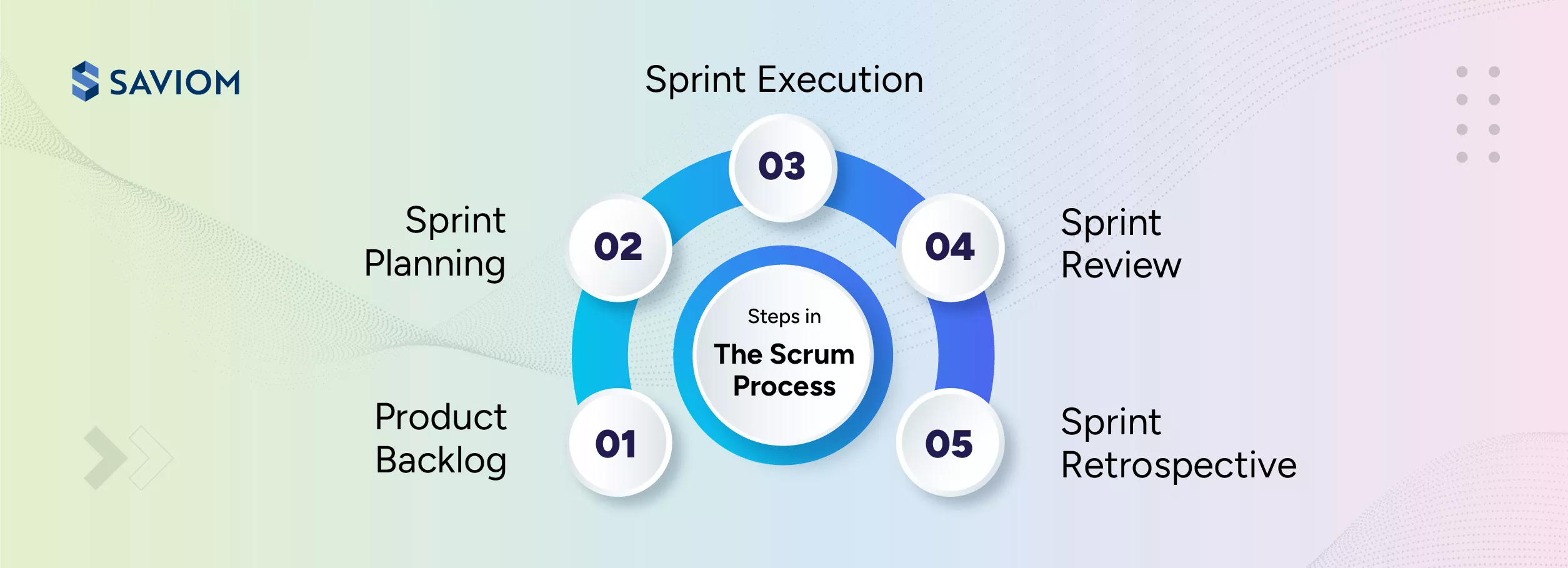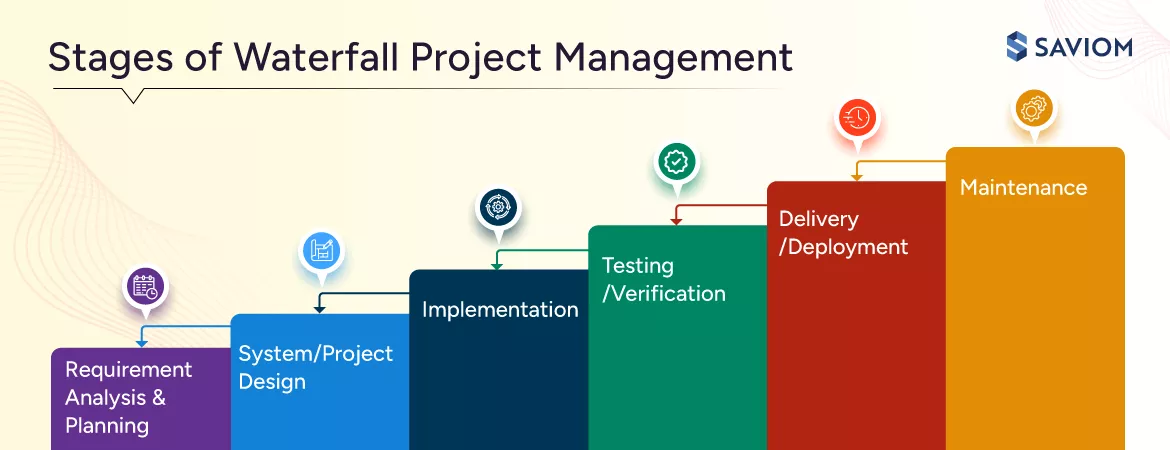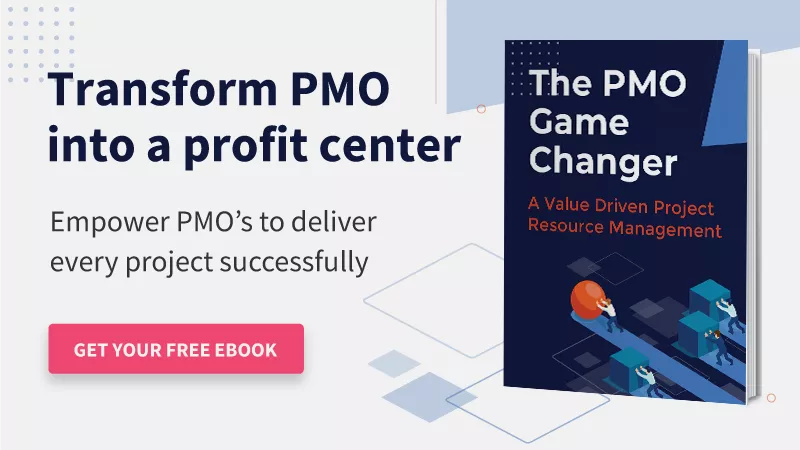Every project is a unique endeavor with distinct goals, deliverables, KPIs, and resource requirements. Choosing the right project management methodology is a critical factor that can significantly impact your project’s success rate and, ultimately, the bottom line.
Among the various methodologies available, the debate between Scrum vs. Waterfall has been at the forefront of countless boardroom discussions. Tech leaders and project managers often advocate for one over the other, highlighting the strengths of their preferred approach.
To make an informed decision, it is vital to understand the key differences between these two methodologies and how they align with your project’s needs.
This article explains the waterfall vs. scrum methodology in detail and helps you decide which framework to choose for your next project.
Let’s start with the definitions:
What is Scrum Methodology?
Scrum is a subset of Agile project methodology and one of the most popular frameworks. It relies on iterative and incremental procedures, which makes it highly effective for managing complex software and product development projects.
Scrum methodology emphasizes collaboration and adaptability. It enables teams to respond quickly to changing requirements and priorities while delivering high-quality output.
To gain a detailed understanding of scrum methodology, it is crucial to comprehend different scrum roles. Let’s go through them.
Different Scrum Roles
Product Owner
The Scrum Product Owner (PO) acts as the bridge between the stakeholders and the development team. They are responsible for understanding customer and business needs, managing the product backlog, and prioritizing tasks to maximize value. Moreover, the Product Owner must balance project stakeholders’ interests and ensure team alignment to drive the successful delivery of the product vision.
Scrum Master
The Scrum Master assists the team in achieving the best results by organizing meetings to address roadblocks and resource-centric challenges. They work with the Product Owner to refine and prepare the product backlog for the next sprint. In addition, the Scrum Master ensures the team follows the scrum process and mentors them to achieve high-quality output.
Scrum Team
The Scrum Team comprises seven to ten professionals, including the Product Owner, Scrum Master, and Development Team. The development team includes operations engineers, designers, UX specialists, testers, and more professionals based on the project’s specific requirements. The Scrum Team estimates how long each task will take and executes the work to achieve the sprint goals.
Now that we know about the different roles, let’s explore the steps in the Scrum process.
Steps in the Scrum Process
Scrum draws upon many sprint structuring events such as Product Backlog, Sprint Planning, Sprint Execution, Sprint Review, and Sprint Retrospective.
Let’s learn about them in more detail here:
Product Backlog
The scrum product backlog is a breakdown of all tasks that need to be performed within the project. The product owner (PO) prepares it and prioritizes the functions in accordance with what is more critical for the project. Moreover, all the tasks or product backlog that a scrum team can execute within one sprint are planned in a sprint planning event.
Sprint Planning
Scrum is executed in fixed iterations called sprints, typically lasting 2 to 4 weeks. The sprint planning meeting is held at the beginning of each Sprint and includes all team members. Led by the scrum master, the team reviews the work the product owner wants to complete in the sprint. During each sprint, the team also discusses a sprint backlog and sprint goal that defines the focus of each sprint.
Sprint Execution
The scrum execution phase brings the sprint plan to life. For that, the development team works on completing user stories while the scrum master conducts daily stand-ups to resolve roadblocks and maintain team alignment. Additionally, the product owner clarifies requirements and adjusts priorities as needed.
Sprint Review
The sprint review happens at the end of each sprint and focuses on the product. The scrum team demonstrates completed work to stakeholders, gathers feedback, and refines the product backlog with the product owner. This ensures the deliverables align with project goals and helps plan for future sprints. It also strengthens collaboration between the team and stakeholders.
Sprint Retrospective
The sprint retrospective occurs after the sprint review and is an internal meeting for the scrum team. It focuses on the team’s performance and process improvement, where the team reflects on what went well, what didn’t, and how to improve. This meeting encourages open communication and fosters a culture of learning to improve collaboration, employee productivity, and quality in upcoming sprints.

Now that we understand scrum methodology, let’s explore the Waterfall project management framework.
Read More: What is Agile Project Management & How to Effectively Manage Resources?
What is Waterfall Methodology?
The waterfall model is a linear systematic methodology where stakeholders’ requirements are gathered at the start of the project. Then, a sequential project plan is developed to accommodate those requirements.
The waterfall model is so named as every stage of the project slides or falls downhill, like a cascade or a waterfall. In the waterfall method, client involvement is minimal during the development phase.
Here, only the final version is shown to the end-users once the product is ready.
Let’s understand its different stages.
Stages of Waterfall Project Management
The waterfall model consists of five to seven distinct phases that typically follow in a linear sequence. In this approach, the output of one phase becomes the input of the next, and there is no overlapping of the stages. This rigid structure ensures a clear progression of the project with limited flexibility.
The linear phases described in the waterfall model are:
Requirement Analysis & Planning
One critical aspect of the waterfall method is that managers gather all customer requirements at the beginning of the project. They carefully document these details, which allows them to plan all the phases without further client involvement until the project is complete. Moreover, a well-defined project planning process reduces the likelihood of scope creep and lays the foundation for successful delivery.
Key requirements that are documented in this phase are:
- Scope: What does the project need to achieve?
- Tasks: What are the different actionable pieces?
- Dependencies: How are tasks linked together?
- Resources: What are the tools, budget, and people needed?
- Timeline: How long will each stage take?
Read More: What is a Project Plan & How to Create an Effective One?
System/Project Design
The design phase has two subphases: logical design and physical design. The logical design subphase is when team members brainstorm and theorize. On the other hand, the physical design subphase is the stage where those theoretical ideas are mapped out with specifications to guide implementation. These phases ensure the project meets all requirements and objectives.
Key activities include:
- Creating schedules and project milestones.
- Defining deliverables and their specifications.
- Mapping out system architecture and workflows.
- Documenting all design decisions for future reference.
Implementation
In the implementation phase, the team executes the project plan and brings the design to life. This phase focuses on creating the deliverables, monitoring progress, and resolving any issues to stay on track. For instance, in software development projects, the implementation phase is a development or coding stage where programmers produce actual codes as per the project specifications.
Key activities include:
- Developing and testing features as per specifications.
- Documenting the implementation process for future reference.
- Addressing and resolving any issues that arise during execution.
- Allocating resources to tasks and activities effectively.
Read More: What is Resource Allocation, and Why is it Important?
Testing/Verification
The testing phase ensures the product meets all requirements and functions as expected. For instance, in a software project, quality assurance (QA) testers identify bugs or errors, and the development team resolves them through debugging. This step verifies the product’s reliability and prepares it for release. Additionally, thorough documentation of testing results helps prevent recurring issues in future phases.
Key activities include:
- Conducting detailed QA tests and documenting results.
- Identifying and fixing bugs or glitches.
- Ensuring the product meets all stipulated requirements.
- Validating functionality across different use cases.
Delivery/Deployment
The delivery phase is the last stage of the development cycle, where the product or application is officially deployed to the client site or released into the market. Key aspects of this phase include thorough testing, user training, and documentation to ensure successful implementation. Furthermore, in software projects, this step involves deploying the application to live environments.
Key deliverables include:
- Releasing the product to clients or end users.
- Coordinating with stakeholders for a seamless launch.
- Ensuring all deliverables meet specified requirements.
- Preparing training materials or user guides.
Maintenance
The maintenance phase begins after the product is delivered and continues throughout its lifecycle. This is an ongoing stage where a group or a specific team member is constantly in touch with the client and provides maintenance support on the product or service. Moreover, it ensures the product remains aligned with user needs and continues to meet performance standards.
Key activities include:
- Fixing any bugs or issues that arise.
- Monitoring product performance and stability.
- Providing regular updates to improve the product.
- Offering customer support and troubleshooting.

Read More: What are the Different Project Management Methodologies?
Now that we have gone through the waterfall method stages, let’s explore the major differences between scrum and waterfall.
Scrum vs. Waterfall: Key Differences
There are several differences between the scrum and waterfall project management methods. These differences are outlined in the table below:
| Parameters | Scrum | Waterfall |
|---|---|---|
| Definition | An Agile framework where projects are carried out in short, iterative cycles called sprint | A traditional project management method that follows a linear, sequential approach |
| Flexibility | Highly adaptable to change as plans or priorities can be modified during sprints as per feedback | Limited flexibility as changes are difficult to incorporate once a phase is completed |
| Deliverables | The product is delivered in small increments. Stakeholders get frequent updates and can review progress throughout the project | The final product is delivered only at the end of the entire project |
| Team Structure | Teams are cross-functional and self-managed. Key roles are Product Owner, Scrum Master, and Development Team | Teams follow a hierarchical structure where the project manager oversees the entire project lifecycle |
| Risk Management | Risks are assessed and addressed continuously throughout the project | Risks are mainly evaluated during the initial stages of the project |
| Feedback | Feedback is gathered regularly during each sprint | Feedback is limited and typically happens only at the end of the project |
| Applications | Ideal for projects with evolving or unclear requirements, such as software development projects | Best for projects with fixed, well-defined requirements from the start, like construction or manufacturing projects |
Read More: Essential Project Management Tips for Beginners
In the next section, let’s compare the pros and cons of the scrum vs. waterfall framework
Pros and Cons of Scrum vs. Waterfall Framework
Choosing the right project management methodology plays a vital role in the success or failure of a project. Let’s examine the comparative advantages and disadvantages of scrum and waterfall methodologies here:
Benefits of Waterfall Methodology
- The stages do not overlap and are completed one at a time. This makes the deliverables of all stages more straightforward.
- It works well for small projects where the scope and requirements are well-defined at the initiation stage. It provides clear timelines and helps in estimating costs upfront.
- Since the scope is well-defined, there are fewer changes during the project lifecycle. This helps control the project budget and maintain the timeline.
- Client involvement is not required during the execution stage except for project reviews, critical approvals, status meetings, etc.
- It is a process-oriented framework with less dependency on individual team members.
Limitations of Waterfall Methodology
- This model is not suitable for complex projects with longer durations.
- The cost of fixing any functionality failure or issues is very high. It also negatively impacts the project quality and causes delivery delays.
- Since the waterfall development approach is process-oriented, requests for modification at the latter stages of the development cycle are unlikely to please.
Read More: What Project Interdependencies Span Your Portfolio?
Benefits of Scrum Framework
- The scrum framework provides more project visibility with daily stand-up meetings. Therefore, issues are identified early, which allows managers to resolve them intelligently ahead of the curve.
- It is considered a collaborative and practical approach to executing complex software development projects.
- The client and stakeholders have frequent and early opportunities to get a glimpse of the development of the project/product. This helps them to make timely decisions on any modifications or changes well in advance.
- Scrum facilitates constant project communication with team members. It ensures the team is aware of all issues and works to resolve them proactively.
- The scrum method promotes incremental development which facilitates faster delivery time and higher-quality deliverables.
Limitations of Scrum Framework
- With no specific end date for the project, some scrum projects can experience scope creep as stakeholders may request additional features throughout the development cycle. It also adversely affects the project costs and timelines.
- Teams need significant training to understand scrum principles, processes, and tools, which can be time-consuming.
- In the scrum team, there are no definite roles. This ambiguity can lead to confusion or misunderstandings.
In the following section, we will look at the importance of resource planning in scrum and waterfall project management frameworks.
Read More: 5 Ways to Reduce Project Management Costs
Importance of Resource Planning in Scrum vs. Waterfall Methodology
Resource planning is crucial in both scrum and waterfall methodologies as it helps optimize team utilization and productivity, address skill mismatches, and keep projects on track.
Resource Planning in Waterfall Methodology
In Waterfall, where the project follows a linear and sequential flow, effective resource planning ensures that the right resources are available at each phase to avoid delays or bottlenecks, as delays in one phase can affect the entire project timeline. Here is how it works:
- In the waterfall method, all resource requirements are thoroughly documented in the planning phase. The probability of any sudden resource changes down the project lifecycle is extremely low since it is appropriately planned in the beginning. So, resource forecasting and estimation can be done more accurately.
- In an IT development project, resources with multiple skills are identified for each phase. For example, an analyst hands over requirements to a developer, who then passes them to testers. In Waterfall, this sequential approach enables resource allocation to specific phases before the project begins.
- A project experiences a ramp-up of resources during the execution stage. Later on, when the major development tasks are completed, there is a ramp-down of the same resources. Here, resource planning allows managers to properly manage ramp-down phases to minimize bench time and ensure billability.
Read More: What is Resource Planning, and Why is it Important in Project Management?
Resource Planning in Scrum Methodology
In scrum, resource planning is more flexible and iterative. It ensures that resources are allocated efficiently within sprints, preventing over-allocation and enabling quick adjustments to meet evolving demands. Here is how it works:
- In an Agile environment, where requirements are constantly evolving, resource planning becomes a critical challenge. That’s why it’s essential to assess and plan resource needs at the sprint level and ensure each iterative cycle has the appropriate resources allocated.
- Scrum teams are inherently cross-functional, comprising members with diverse skill sets and expertise. Here, efficient resource planning helps distribute the workloads evenly, promotes skill sharing, and fosters collaboration.
- Most scrum projects operate within a small team size. Therefore, resources are assigned to iterations (or sprints) rather than the entire project, and they may be simultaneously assigned to multiple sprints. When a specific task of a niche resource is entirely completed, they are released from the project.
Now that we understand how important resource planning is for both methodologies, let’s explore which approach suits your project best.
Read More: Mastering Project Resource Management: A Comprehensive Guide
Scrum vs. Waterfall: Which Methodology Best Fits Your Project?
It is vital to choose the right management approach in order to execute projects on time and within budget. With a variety of methodologies like Waterfall, Agile, Scrum, and Kanban available, selecting the one that aligns best with your project’s objectives and environment is key to maximizing success.
Each project management methodology comes with its own set of principles, practices, and tools, but they all share the same fundamental goal: to deliver the project successfully within the constraints of time, scope, and budget. However, the approach you take can significantly impact how effectively the project runs and how well the team collaborates, adapts, and delivers results.
But how do you decide on which methodology to adopt?
The answer to this question depends on the following attributes:
- The team and the project’s unique needs
- Size and complexity of the project
- Organizational factors
- Project timeline and budget
- Client and stakeholder involvement
- Risk tolerance
Ultimately, there is no one-size-fits-all answer when choosing between scrum and waterfall. Scrum is perfect for complex, dynamically changing projects that require flexibility, constant feedback, and a collaborative team environment.
Meanwhile, the waterfall model is ideal for projects with clear, predictable outcomes that require proper structure and detailed planning. By carefully considering these factors, you can select the methodology that best aligns with your project goals and sets the stage for successful delivery.
Read More: 25 Must-Have Project Management Skills for Every Professional
Having understood which approach suits your project, let’s explore whether a hybrid approach might be a good fit.
Is Hybrid Approach the Right Choice for Your Project?
Today, most modern organizations implement a hybrid model, which combines two or more project management frameworks. This approach helps bring the best of two or more methodologies and circumvent the limitations traditionally associated with a singular method. Therefore, it leads to better project execution and control, resulting in successful delivery and better client satisfaction.
For instance, in a software development project, you can use the waterfall method to gather client requirements and create a detailed project plan. However, during the execution stage, you can switch to an agile scrum approach.
Employing the waterfall method during the initiation stage helps determine the project scope and establish deadlines for all deliverables. On the other hand, the agile approach helps you execute the project flexibly, accommodate change requests adequately, and deliver results as per expectations.
Read More: What is Diversity in Project Management and its Importance?
Conclusion
When running and managing resources in a complex project, implementing Waterfall, Scrum, or even a combination of the two can often be challenging. Therefore, using a modern resource management tool can be beneficial. It helps plan and schedule resources for each sprint and different project life cycles.
Which methodology do you follow to manage your projects?
The Glossary
Read More: Glossary of Resource Workforce Planning, Scheduling and Management












